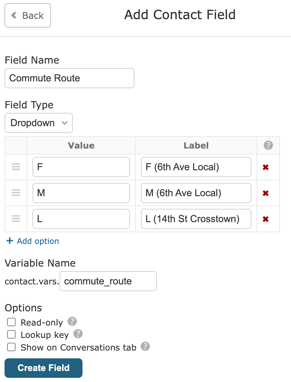Managing Contact Fields in Telerivet
Contact fields define the data you store about each person in your audience. They shape how you segment contacts, personalize messages, and understand your program at scale.
This guide explains how contact fields work, how to create and manage them, and how to use field options like lookup keys and read-only modes.
Contact fields are one of the most versatile parts of Telerivet. You can keep your data structure simple or design a richer model that supports advanced communication workflows.
What Contact Fields Are
Each contact in Telerivet contains fields that store information. Some fields are built in, such as:
- Name
- Phone Number
- Last Heard From
- Last Contacted, etc
Beyond these, you can create custom fields to store any information relevant to your program, such as:
- Household or ward
- Beneficiary ID or student ID
- Branch or region
- Risk category or eligibility
- Preferred communication language
- Customer tier
- Enrollment or registration date, etc
Custom fields help Telerivet fit many different use cases across nonprofits, government programs, healthcare, schools, retail businesses, FMCG, logistics and service organizations.
For an overview of how fields connect to the rest of your contact structure, see:
Understanding Contacts in Telerivet
Where You Manage Contact Fields
Contact fields are managed through the Manage Fields page. Here you can:

- Add new fields
- Edit existing ones
- Delete fields you no longer use
- Adjust field types and options
- Set which fields appear in conversations
- Control which fields act as lookup keys
This central view helps you maintain a clean and consistent data model.
Creating New Contact Fields
When adding a new field, you define:
Field Name
A clear label such as “Region”, “Program Status”, or “Member ID”.
Telerivet automatically assigns a variable name used internally by the system.
Field Type
The data format you want to store. eg:text, number, yes/no, Dropdown etc.
Choosing the right type ensures better filtering, segmentation, and consistency.
Field Options
Contact fields include optional settings that control how they behave.

Read-Only Fields
Some fields cannot be changed manually because they are system generated or updated automatically. Examples: Last Heard From, Last Contacted, Message counts, Time Created, Last Updated, etc
Read-only fields help you track engagement and system behavior without accidental changes.
You can also mark your own custom fields as read only when you want them controlled by external systems or automated workflows.
Lookup Key
A lookup key is used to match imported or API data to an existing contact.
Phone Number is the default lookup key, but you can assign additional ones such as: CRM ID, Account ID, Student ID, etc.
This prevents duplicate records. When a lookup key matches an existing contact, Telerivet updates that record rather than creating a new one.
If you do not need a secondary lookup key, the default phone number key is already enough to keep your data clean.
For guidance on imports, see:
Importing Contacts Into Telerivet
Show on Conversations Tab
Enable this option when a field should be visible for agents or staff responding to messages. Examples: Priority level, Case manager name, Risk category, Beneficiary status, etc.
This allows your team to quickly understand who they are interacting with during conversations when using Telerivet's conversation view.
Editing or Deleting Fields
You can edit:
- Field names
- Dropdown options
- Field types (when compatible)
- Display settings
- Variable names
Deleting a field removes it from all contacts, so this should be done only when you are sure the data is no longer needed.
If you want to reorganize your data model, consider renaming or updating field types instead of deleting.
Read more: Adding custom fields
Best Practices for Designing Contact Fields
A clean field structure makes every part of Telerivet work better. Here are some guidelines:
- Use short, descpriptive field names
Clear labels help avoid confusion across teams. - Use consistent naming
For example, choose either “Branch” or “Location” and stick with it across all imports. - Choose the simplest field type that works
For example, use Yes/No instead of Text for binary values. - Standardize dropdowns
Dropdowns enforce consistency and prevent typos. - Reserve lookup keys for fields that are truly unique
Only IDs or phone numbers should act as unique identifiers. - Avoid too many fields
Start lean. Add more fields as your program grows.
How Contact Fields Power Telerivet
Contact fields support key features across the platform:
- Filters and dynamic groups use field values to build segments
- Campaigns target groups defined by field rules
- Automated services use fields in conditions and personalization
- Messages use field values in templates and body
- Imports map spreadsheets to fields
- APIs read and update field values for sync workflows
Fields are the connective tissue across the entire communication system.